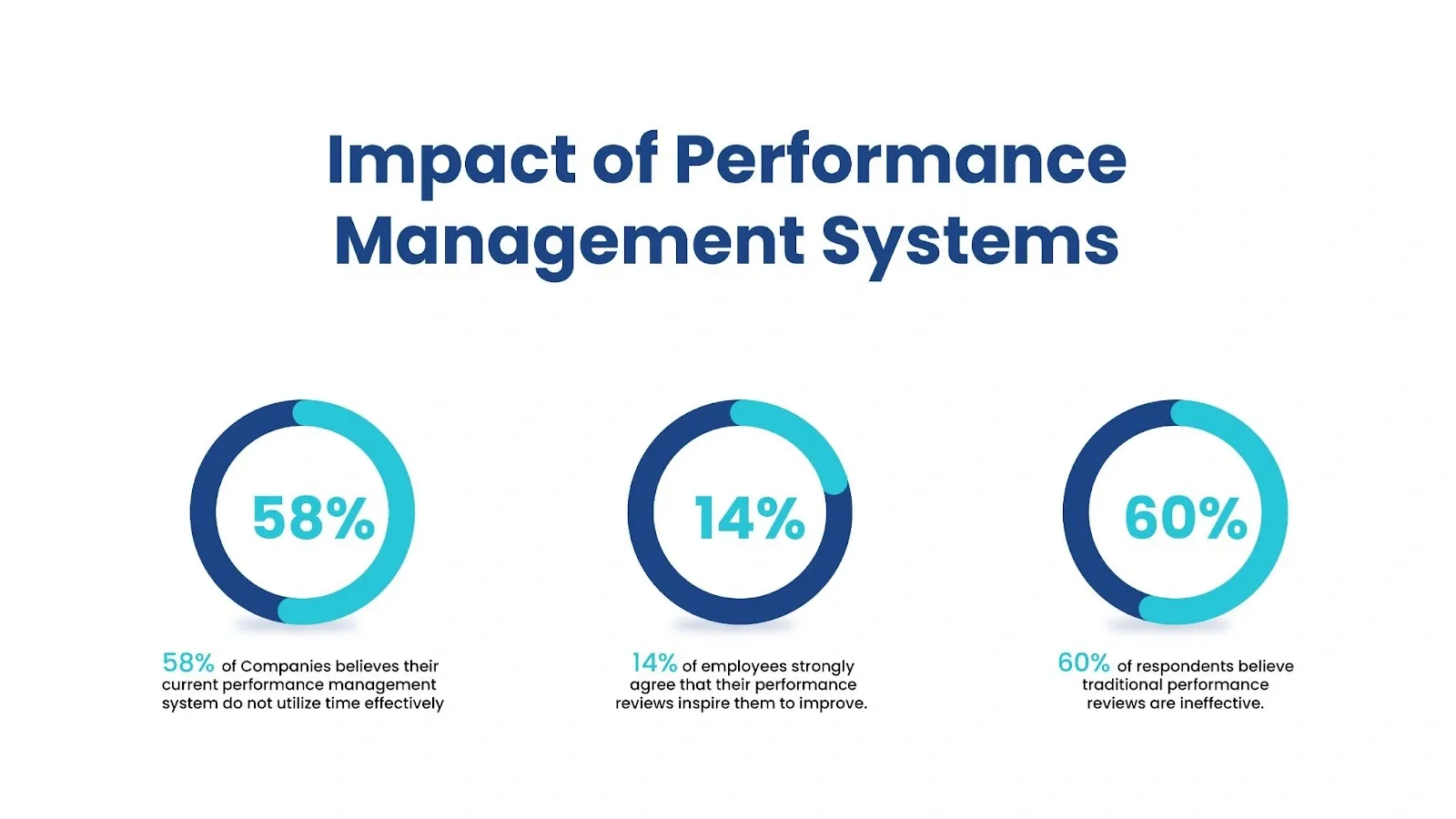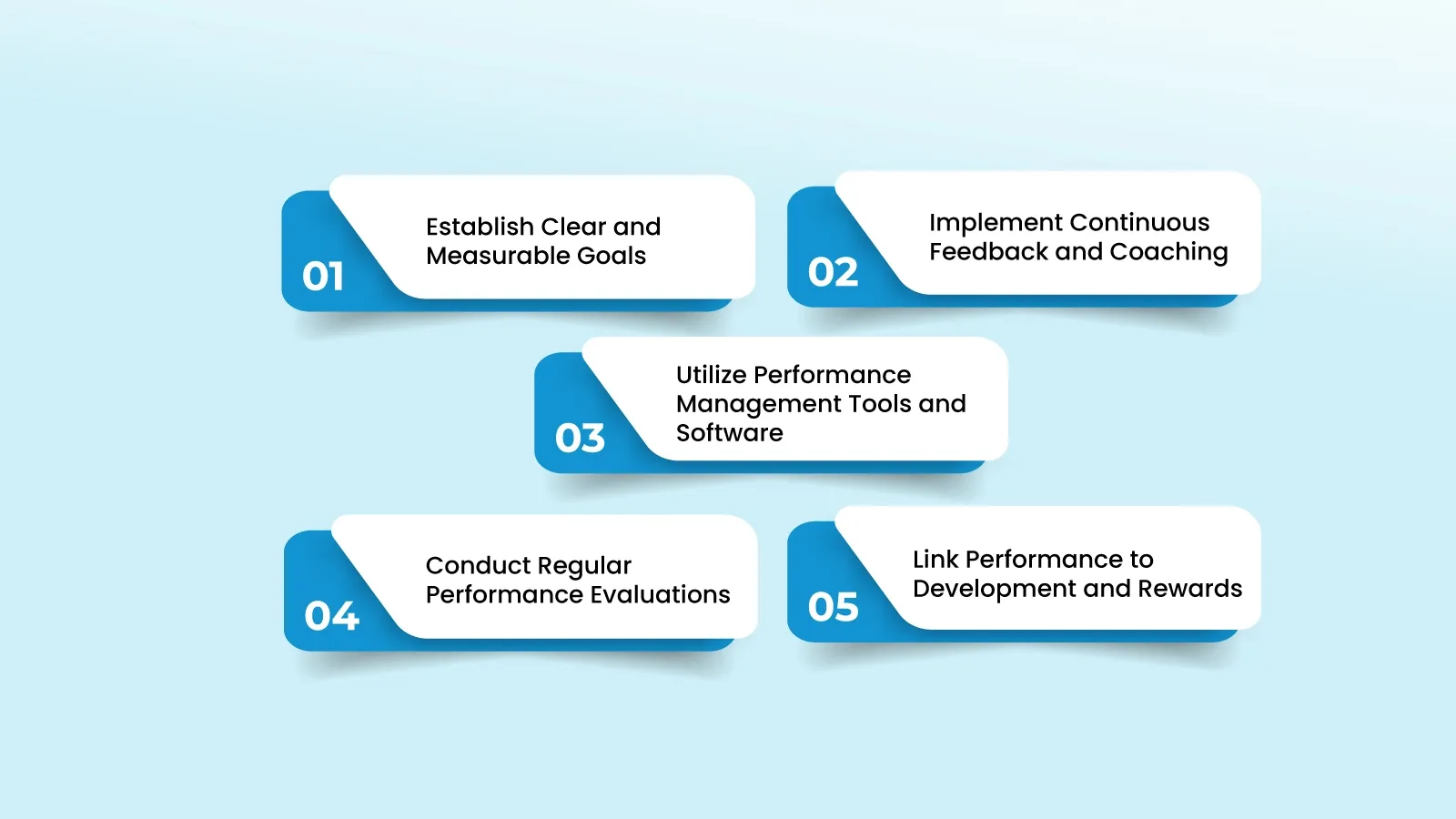How to set an effective performance management process in 2024?

Are you exhausted from revamping your performance management processes annually?
In the ever-changing business environment, maintaining a competitive edge necessitates constantly refining performance management tactics. It can be tiresome to devise new processes year after year.
To remain competitive, companies must persistently enhance their approaches to performance management.

Did you know that 58% of companies indicate that their performance management systems do not effectively utilize time? Well, that's a huge number!
Also Research from Gallup indicates that only 14% of employees strongly agree that their performance reviews inspire them to improve.
A survey conducted by PwC found that 60% of respondents believe traditional performance reviews are ineffective.
In this blog, we will discuss how to set up an effective performance management process and some common pitfalls to avoid.
Understanding the Basics of Performance Management
Performance management is a systematic process that aims to improve organizational effectiveness by enhancing individual performance. Key components of the performance management process include:
- Goal Setting: Establishing clear, measurable objectives aligned with organizational goals.
- Continuous Feedback: Providing regular, constructive feedback to guide employee development.
- Performance Evaluation: Assessing employee performance against set objectives.
- Development Planning: Identifying opportunities for professional growth and creating plans for skill enhancement.
- Recognition and Rewards: Acknowledging achievements and incentivizing high performance.
Objectives of performance management
- Align Individual and Organizational Goals: Ensure that employees' objectives contribute to the overall success of the company.
- Enhance Employee Performance: Continuously improve the efficiency and effectiveness of individual performance.
- Facilitate Employee Development: Identify and address development needs to promote career growth.
- Improve Communication: Foster open dialogue between managers and employees regarding expectations and performance.
- Support Decision-Making: Provide data-driven insights for informed decisions on promotions, compensation, and workforce planning.
- Boost Employee Engagement: Increase motivation and commitment by recognizing and rewarding achievements.
- Drive Organizational Success: Contribute to the achievement of strategic goals by optimizing individual and team performance.
Importance of Performance Management
The importance of the performance management process is multifaceted and impacts various aspects of an organization. Here are some key points highlighting its significance:
- Aligns Individual Goals with Organizational Objectives: The performance management process ensures that the goals of individual employees are aligned with the broader objectives of the organization. This alignment is crucial for driving the overall success of the company and ensuring that everyone is working towards a common purpose.
- Enhances Employee Performance: A well-structured performance management process provides a framework for consistently improving employee performance. By setting clear expectations, providing regular feedback, and offering development opportunities, employees are motivated to perform at their best.
- Facilitates Employee Development: The performance management process is not just about evaluating past performance but also about identifying opportunities for future growth. Through coaching, training, and feedback, employees can develop their skills and advance their careers within the organization.
- Improves Communication: Effective performance management fosters open communication between managers and employees. Regular check-ins and feedback sessions create a platform for discussing achievements, challenges, and goals, leading to a more transparent and communicative workplace.
- Aids in Decision-Making: Data collected through the performance management process can inform important organizational decisions, such as promotions, compensation adjustments, and workforce planning. This data-driven approach ensures that decisions are based on objective criteria and contribute to the overall effectiveness of the organization.
- Boosts Employee Engagement: When employees see that their efforts are recognized and their development is supported, their engagement and commitment to the organization increase. The performance management process plays a crucial role in building a positive work environment where employees feel valued and motivated.
- Supports Strategic Planning: The performance management process provides valuable insights that can shape the strategic direction of the organization. By analyzing performance data, leaders can identify trends, strengths, and areas for improvement, which can inform future planning and goal-setting.
Setting Up an Effective Performance Management Process

Step 1: Establish Clear and Measurable Goals
The first step in the performance management process is to establish clear and measurable goals. These goals should be aligned with the organization's overall objectives and should be specific, measurable, achievable, relevant, and time-bound (SMART). By setting clear goals, employees know what is expected of them, and managers have a benchmark to measure performance.
Step 2: Implement Continuous Feedback and Coaching
Continuous feedback and coaching are crucial components of the performance management process. Managers should provide regular feedback to employees on their performance, highlighting areas of strength and areas for improvement. Coaching sessions can be used to develop employees' skills and address any performance gaps. This ongoing support helps employees stay engaged and motivated to achieve their goals.
Step 3: Utilize Performance Management Tools and Software
To streamline the performance management process, organizations can utilize various tools and software solutions. These tools can help track employee performance, set and monitor KPIs & goals, provide feedback, and conduct evaluations. By leveraging technology, managers can more efficiently manage performance and gather data to inform decision-making.
Step 4: Conduct Regular Performance Evaluations
Regular performance evaluations are a key part of the performance management process. These evaluations should be based on the predefined goals and metrics established in Step 1. Evaluations provide an opportunity for managers and employees to review progress, discuss achievements, and identify areas for improvement. It's important to approach these evaluations with a constructive and collaborative mindset.
Step 5: Link Performance to Development and Rewards
Finally, the performance management process should link performance to development and rewards. Employees who meet or exceed their performance goals should be recognized and rewarded accordingly. This could include bonuses, promotions, or other incentives. Additionally, development opportunities, such as training or mentoring programs, should be offered to help employees grow and advance in their careers.
Avoiding Common Pitfalls in Performance Management
- Set Realistic and Relevant Goals : One of the common pitfalls in the performance management process is setting goals that are either unrealistic or not aligned with the organization's objectives. To avoid this, ensure that all goals set during the performance management process are realistic, achievable, and directly tied to the company's overall strategy.
- Provide Regular, Constructive Feedback : Another pitfall is the lack of regular feedback. Employees should receive continuous feedback throughout the performance management process, not just during formal evaluations. This feedback should be constructive, focusing on how employees can improve and develop their skills.
- Avoid Bias in Evaluations: Bias in performance evaluations can significantly undermine the effectiveness of the performance management process. To avoid this, use objective criteria and multiple data sources when assessing performance. Train managers to recognize and mitigate their biases.
- Ensure Two-Way Communication: A common mistake in the performance management process is treating it as a one-way conversation. Instead, encourage open and two-way communication between managers and employees. This fosters a collaborative environment where feedback and concerns can be shared freely.
- Emphasize Development Over Punishment: The performance management process should focus on employee development rather than just highlighting shortcomings or administering punishments. Use performance evaluations as opportunities to identify areas for growth and provide resources for professional development.
- Adapt to Change: The business environment is constantly changing, and so should your performance management process. Be flexible and willing to adjust goals and strategies as needed. This ensures that the process remains relevant and effective in driving performance.
- Monitor and Review the Process: Finally, regularly monitor and review the performance management process itself. This allows you to identify areas for improvement and make necessary adjustments. A well-monitored process helps in achieving the desired outcomes and maintaining employee engagement.
After reading this blog, it becomes clear that performance management is a challenging endeavor. Implementing effective strategies will demand additional effort and time. To adapt to the evolving landscape of performance management, embracing advanced tools is crucial for enhancing performance. A notable tool in this regard is getCREDIBLE.
Introducing getCREDIBLE
getCREDIBLE aids in building professional networks by authenticating your credibility in your industry. This platform offers a distinctive feature that allows you to digitally display your skills and projects while garnering genuine feedback. Additionally, you can record your accomplishments and develop a digital portfolio, known as a "slate" in getCREDIBLE parlance. Key features that set getCREDIBLE apart include:
- Slate: Your digital resume.
- AI-Assisted Milestones: Intelligent tracking of your professional achievements.
- Feedback System: Enables receiving and providing authentic feedback.
- Digital Slate Creation: Simplifies the process of building and sharing your digital portfolio.
Conclusion
Setting an effective performance management process involves clear goal-setting, continuous feedback, and regular evaluations. Tools like getCREDIBLE can enhance this process by providing a platform for showcasing achievements and receiving credible feedback, thus fostering professional growth and credibility within the industry.
Explore getCREDIBLE today.
